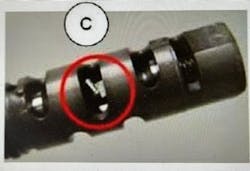Measure the Resistance Between Hyundai Terminals
This bulletin applies to Hyundai vehicles equipped with CVVT (continually variable valve timing). When diagnosing the CVVT system for rough idling, poor acceleration, camshaft timing misalignment-related DTCs, misfire-related DTCs and/or other related symptoms, it may be required to inspect the OCV (oil control valve) for proper operation. Measure the resistance between the OCV power and signal terminals.
For Denso OCV, resistance should be 6.9-7.9 Ohms at 68 degrees F. For Delphi OCV, the value should be 6.7-7.7 Ohms. Check if the PCV operates normally by providing 12V power. Careful attention is necessary to avoid a short circuit when providing the PCV with 12V power. Spacing between the power and signal terminals is very narrow. Use suitable connections to prevent shorting of the test power supply.
When 12V power is applied to the OCV, the OCV must move forward. With no power applied, the OCV is in maximum retarded valve timing condition. With 12V power applied and the valve moving forward, the OCV is in maximum advanced valve timing condition.
If the valve does not move, inspect the valve for debris 9such as an aluminum chip, etc.). Blow any debris out. If the valve is not damaged, there is no reason to replace it. If the valve is damaged, obviously it must be replaced.
About the Author
Information courtesy of Mitchell 1
Information for Technical Service Bulletins comes from ProDemand, Mitchell 1's auto repair information software for domestic and import vehicles. Headquartered in San Diego, Mitchell 1 has provided quality repair information solutions to the automotive industry since 1918.
